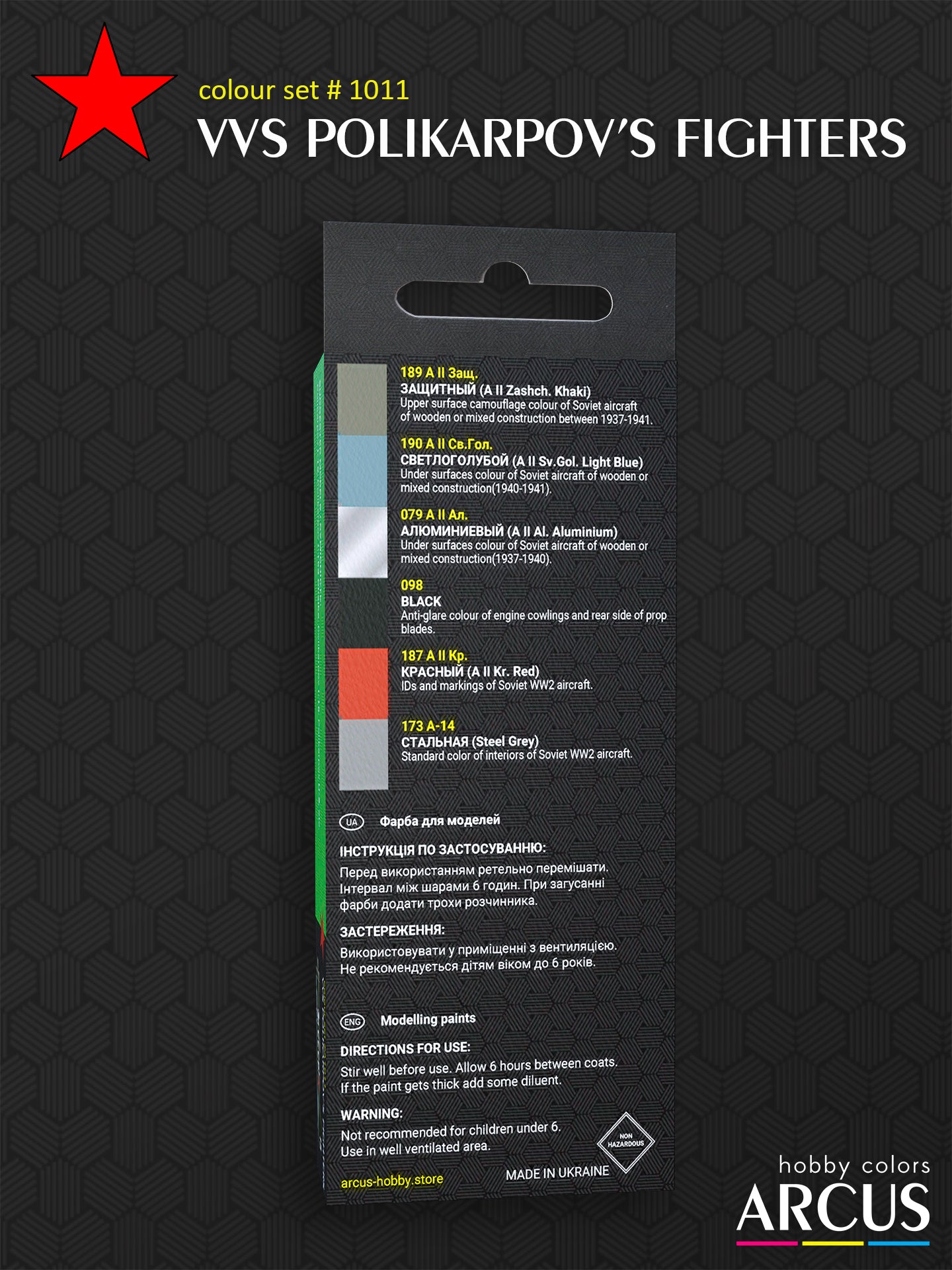Arcus Hobby
Paint Set 1011 VVS Polikarpov's Fighters
Couldn't load pickup availability
VVS Polikarpov's Fighters
In the tumultuous era leading up to World War II, the Polikarpov Design Bureau, under the visionary guidance of Nikolai Nikolaevich Polikarpov, produced a series of iconic fighters that played a crucial role in shaping the Soviet Union's air power. These nimble and agile aircraft, known for their distinctive design and formidable performance, became synonymous with Soviet aviation prowess during the 1930s and World War II.
The Polikarpov I-15, affectionately nicknamed "Chaika" (Seagull), marked a significant milestone in aviation history as one of the world's first production monoplane fighters. Introduced in 1934, the I-15 featured a gull-wing design and an open cockpit, capturing the attention of aviation enthusiasts globally. Its maneuverability and ease of maintenance made it a favorite among Soviet pilots.
As the political climate in Europe became increasingly volatile, the Polikarpov I-15 found itself thrust into the crucible of the Spanish Civil War (1936-1939). Pilots from the Soviet Union, supporting the Republican faction, operated the I-15 against Nationalist forces and their German and Italian allies. This conflict served as a testing ground for both aircraft and pilots, solidifying the reputation of the I-15 as a formidable dogfighter.
The subsequent evolution of Polikarpov's designs led to the introduction of the I-16, a monoplane fighter with retractable landing gear and a top speed that outclassed its contemporaries. The I-16, affectionately nicknamed "Ishak" (Donkey) by Soviet pilots, became the world's first production monoplane with retractable landing gear and set the standard for modern fighter aircraft.
With the outbreak of World War II, the Polikarpov I-16 became a mainstay in the Soviet Air Force, engaging in fierce aerial combat against the German Luftwaffe on the Eastern Front. Notable Soviet aces Boris Safonov and Vasily Golubev achieved numerous victories flying the I-16, showcasing the aircraft's effectiveness in the hands of skilled pilots.
Despite being eventually outclassed by more advanced fighters, the Polikarpov fighters left an indelible mark on aviation history. Their impact extended beyond their operational lifespan, influencing future Soviet aircraft design and contributing to the legacy of Soviet aces who fought valiantly in defense of their homeland. The Polikarpov fighters, with their distinctive designs and storied combat history, stand as enduring symbols of Soviet aviation excellence during a pivotal period in world history.
Use Guide for the Set VVS Polikarpov's Fighters
- In 1937, new second-generation aero lacquers (A II) were approved for use, and aircraft of the Red Army received new camouflage colors. The upper surfaces of wooden or mixed-construction aircraft were intended to be painted with protective lacquer A II Zashch. Zashchitny (Protective). The lower surfaces were painted in silver lacquer A II Al. Aluminievy (Aluminum).
- By 1940, the color of the lower surfaces was changed from silver to light blue A II Sv. Gol. Svetlogoluboj (Light Blue).
- In 1941, new aviation paints were approved, and aero-lacquers of the A II generation were no longer used.
Set VVS Polikarpov's Fighters Includes:
- 189 А II Zashch. Zashchitny (Protective) - A khaki green camouflage color of the upper surfaces.
- 190 A II Sv. Gol. Svetlogoluboj (Light Blue) - A light blue color of the lower surfaces.
- 079 A II Al. Aluminievy (Aluminum) - A bright silver color of the lower surfaces.
- 098 Black - A deep black color of the anti-glare panels, engine cowlings, and rear sides of the propellers.
- 187 A II Kr. Krasny (Red) - A bright red color of IDs and markings.
- 173 A-14 Stalnaya (Steel Gray) - A medium gray color of the aircraft interior.
Collection:
This Set is Best for:
- Polikarpov I-15
- Polikarpov I-153 Chaika
- Polikarpov I-16
- Polikarpov U-2, etc
Paint Type:
- Acrylic A1011
- Enamel E1011
Paint Finish:
- Semi-gloss
Capacity:
- 6 x 10 ml. (6 x 0.33oz)






